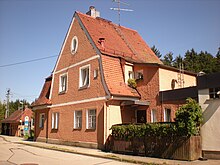Mangfall Valley Railway
| Holzkirchen – Rosenheim | |||||||||||||||||||||||||||||||||||||||||||||||||||||||||||||||||||||||||||||||||||||||||||||||||
|---|---|---|---|---|---|---|---|---|---|---|---|---|---|---|---|---|---|---|---|---|---|---|---|---|---|---|---|---|---|---|---|---|---|---|---|---|---|---|---|---|---|---|---|---|---|---|---|---|---|---|---|---|---|---|---|---|---|---|---|---|---|---|---|---|---|---|---|---|---|---|---|---|---|---|---|---|---|---|---|---|---|---|---|---|---|---|---|---|---|---|---|---|---|---|---|---|---|
| Route number : | 5622 | ||||||||||||||||||||||||||||||||||||||||||||||||||||||||||||||||||||||||||||||||||||||||||||||||
| Course book section (DB) : | 958 | ||||||||||||||||||||||||||||||||||||||||||||||||||||||||||||||||||||||||||||||||||||||||||||||||
| Route length: | 37.0 km | ||||||||||||||||||||||||||||||||||||||||||||||||||||||||||||||||||||||||||||||||||||||||||||||||
| Gauge : | 1435 mm ( standard gauge ) | ||||||||||||||||||||||||||||||||||||||||||||||||||||||||||||||||||||||||||||||||||||||||||||||||
| Route class : | D4 | ||||||||||||||||||||||||||||||||||||||||||||||||||||||||||||||||||||||||||||||||||||||||||||||||
| Power system : | 15 kV 16.7 Hz ~ | ||||||||||||||||||||||||||||||||||||||||||||||||||||||||||||||||||||||||||||||||||||||||||||||||
| Top speed: | 120 km / h | ||||||||||||||||||||||||||||||||||||||||||||||||||||||||||||||||||||||||||||||||||||||||||||||||
| Train control : | PZB 90 | ||||||||||||||||||||||||||||||||||||||||||||||||||||||||||||||||||||||||||||||||||||||||||||||||
|
|||||||||||||||||||||||||||||||||||||||||||||||||||||||||||||||||||||||||||||||||||||||||||||||||
The Mangfalltalbahn ( course book route 958) is a single-track, electrified railway line running through the Mangfalltal between Holzkirchen and Rosenheim , which is only served by regional traffic in the timetable. However, it also serves as a diversion route in the event of disruptions on the Munich – Rosenheim railway line .
history
The Mangfall Valley Railway is part of the first rail connection between Munich and Rosenheim (and on to Salzburg / Kufstein), the so-called Bavarian Maximilians Railway . It was built by the Bavarian state and completed on October 31, 1857. The route ended in the Rosenheim suburb of Am Roßacker . It was not until November 13, 1858, that the first “real” train station in Rosenheim, complete with engine shed and turntable, was inaugurated. The former locomotive shed still exists today and is used as an exhibition building under the name " Lokschuppen Rosenheim ". At that time, the railway line was mainly used to transport coal from the mine in Hausham to the saline brewhouse in Rosenheim.
An electrified local train , which has now been dismantled, ran from Bad Aibling to Bad Feilnbach . There was also a short branch line from Westerham to Vagen , which was still used for passenger transport in the 1940s. Later, the tracks were only used to connect the Leitzachwerke , before they were dismantled in the late 1990s.
The planned double-track expansion was never realized, since in 1871 the newly built direct connection Munich – Rosenheim via Grafing (today timetable route 950/951) took over the function of the main line. In 1971 the line was electrified in order to be able to provide an alternative route for the heavily used line via Grafing. One notices this purpose on the route because the sidings in the stations are unusually long.
Planning for further stops in Feldolling, Hinrichssegen and Rosenheim-Aicherpark began as early as 1995. The basis for this was a cabinet decision of the Bavarian state government, which was initiated by the Rosenheim district office and a study commissioned there. As recently as 2008, Deutsche Bahn wrote that specific times for the commissioning of the planned stops cannot be given. Local politicians made serious allegations against Deutsche Bahn at the time. Meanwhile, the were breakpoint Bad Aibling Kurpark 2009 and the breakpoint Hinrichssegen put into operation on 14 December 2014 (the solemn inauguration took place on July 28, 2015). Two new stops, Feldolling and Rosenheim-Aicherpark , went into operation in 2019. The almost dilapidated station building in Kolbermoor, the oldest building in the city, has been restored in recent years under the direction of the city of Kolbermoor and reopened as a meeting place in September 2019.
Since December 15, 2013, the Bayerische Oberlandbahn has been running the traffic under the name Meridian on behalf of the Bavarian Railway Company . Due to approval problems, the planned three-part Stadler Flirt 3 multiple units were only used from the end of June 2014, but there are also six-part multiple units in service. Since then there have been a few connections from the Mangfall Valley that lead via Holzkirchen to Munich without changing (9 pairs of trains per day).
Accidents
On May 28, 1945, a military train manned by soldiers and an empty train collided on the stretch between Bad Aibling and Kolbermoor. The accident , which occurred in a confusing forest, claimed five lives and 21 injured, some seriously. Part of the cause was the interruption of telephone and telecommunications lines between Bad Aibling and Kolbermoor at the end of the Second World War .
On February 9, 2016, there was a railway accident in Bad Aibling around 800 meters further , in which two regional trains of the Bavarian Oberlandbahn collided. The dispatcher had impermissibly authorized both train journeys on the single-track section between Bad Aibling and Kolbermoor by operating the replacement signal for the train from Bad Aibling . 12 people died in the collision and around 80 people were injured.
Routing
The starting point of the route is in Holzkirchen on the Munich – Holzkirchen route, where the S 3 line of the Munich S-Bahn also ends. Kreuzstrasse station is also the S-Bahn terminus, in this case the S 7 line.
In Rosenheim the line meets the main lines Munich – Rosenheim , Rosenheim – Salzburg and Rosenheim – Kufstein as well as the single-track, non-electrified main line to Mühldorf .
business
The line is operated by DB Netz AG . The stations are operated by DB Station & Service .
The entire route was used by locomotive-hauled push- pull trains until 2000 , after which DB Regio operated electric multiple units of the 425 series. Since the timetable change in December 2013, the route has been served by the Bayerische Oberlandbahn under the Meridian brand as part of the Rosenheim E-Netz . Three- and six-car Stadler Flirt multiple units are used on this route .
Web links
- Pro-Bahn website for the Mangfall Valley Railway ( Memento from September 12, 2017 in the Internet Archive )
- Private website for the Mangfall Valley Railway
Individual evidence
- ↑ Investigation Report train collision, 02.09.2016, Bad Aibling Kolbermoor. Federal Agency for Railway Accident Investigation, October 29, 2018, accessed on July 1, 2020 .



